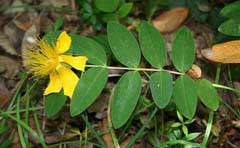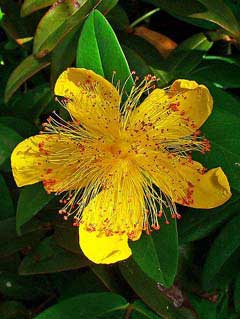 |
|
http://commons.wikimedia.org/wiki/User:Franz_Xaver |
 |
| http://commons.wikimedia.org/wiki/User:Llez |
Translate this page:
Summary
Bloom Color: Yellow. Main Bloom Time: Early summer, Late summer, Mid summer. Form: Spreading or horizontal.
Physical Characteristics

 Hypericum calycinum is an evergreen Shrub growing to 0.3 m (1ft) by 1 m (3ft 3in) at a fast rate.
Hypericum calycinum is an evergreen Shrub growing to 0.3 m (1ft) by 1 m (3ft 3in) at a fast rate.
See above for USDA hardiness. It is hardy to UK zone 6. It is in leaf all year, in flower from June to September, and the seeds ripen from September to October. The species is hermaphrodite (has both male and female organs) and is pollinated by Insects. The plant is self-fertile.
Suitable for: light (sandy), medium (loamy) and heavy (clay) soils, prefers well-drained soil and can grow in heavy clay and nutritionally poor soils. Suitable pH: mildly acid, neutral and basic (mildly alkaline) soils and can grow in very alkaline soils.
It can grow in full shade (deep woodland) semi-shade (light woodland) or no shade. It prefers dry or moist soil and can tolerate drought.
UK Hardiness Map
US Hardiness Map
Synonyms
Plant Habitats
Woodland Garden Sunny Edge; Dappled Shade; Shady Edge; not Deep Shade; Ground Cover;
Edible Uses
References More on Edible Uses
Medicinal Uses
Plants For A Future can not take any responsibility for any adverse effects from the use of plants. Always seek advice from a professional before using a plant medicinally.
None known
References More on Medicinal Uses
The Bookshop: Edible Plant Books
Our Latest books on Perennial Plants For Food Forests and Permaculture Gardens in paperback or digital formats.

Edible Tropical Plants
Food Forest Plants for Hotter Conditions: 250+ Plants For Tropical Food Forests & Permaculture Gardens.
More

Edible Temperate Plants
Plants for Your Food Forest: 500 Plants for Temperate Food Forests & Permaculture Gardens.
More

More Books
PFAF have eight books available in paperback and digital formats. Browse the shop for more information.
Shop Now
Other Uses
Dye
A good ground cover plant[182, 208], succeeding in the heavy shade of trees and in dry shade[190, 200]. Very vigorous, it can swamp out small plants. For the densest cover plants should be cut to ground level each April[197]. A yellow-orange dye is obtained from the flowers.
Special Uses
Ground cover
References More on Other Uses
Cultivation details
Landscape Uses:Border, Cascades, Erosion control, Ground cover, Specimen. Easily grown in any reasonably good well-drained but moisture retentive soil.[1] Succeeds in dry soils[200] and in chalky soils[11]. Grows well in heavy clay soils. Succeeds in sun or shade but flowers better in a sunny position[11]. Grows well even in the shade of tall trees[1, 20, 31]. Tolerates poor soils and also drought when it is established[184]. A very cold-hardy plant, tolerating temperatures down to about -25°c[184]. A very ornamental but very invasive plant, spreading by means of stolons[1, 182]. Seldom sets seed in Britain, probably due to our wet autumns[182]. Plants are often afflicted with rust disease[182, 200]. Plants in this genus are notably resistant to honey fungus[200]. Special Features:
Attractive foliage, Not North American native, Invasive, Naturalizing, Attracts butterflies.
References Carbon Farming Information and Carbon Sequestration Information
Temperature Converter
Type a value in the Celsius field to convert the value to Fahrenheit:
Fahrenheit:
The PFAF Bookshop
Plants For A Future have a number of books available in paperback and digital form. Book titles include Edible Plants, Edible Perennials, Edible Trees,Edible Shrubs, Woodland Gardening, and Temperate Food Forest Plants. Our new book is Food Forest Plants For Hotter Conditions (Tropical and Sub-Tropical).
Shop Now
Plant Propagation
Seed - sow spring in a greenhouse and only just cover the seed. Germination usually takes place within 1 - 3 months at 10°c. When they are large enough to handle, prick the seedlings out into individual pots and grow them on in the greenhouse for their first winter. Plant them out into their permanent positions in late spring or early summer, after the last expected frosts. Cuttings of half-ripe wood 10 - 12 cm with a heel, July/August in a frame. Plant out in the following spring[200]. Cuttings of mature wood, 12 - 17cm with a heel, October/November in a sheltered position outdoors. Plants root by the spring. Good percentage[78]. Division in spring as new growth commences[78]. Very easy, larger clumps can be replanted direct into their permanent positions, though it is best to pot up smaller clumps and grow them on in a cold frame until they are rooting well. Plant them out in the spring.
Other Names
If available other names are mentioned here
Native Range
TEMPERATE ASIA: Turkey (n.w. & n.e.) EUROPE: Bulgaria (southeast)
Weed Potential
Right plant wrong place. We are currently updating this section.
Please note that a plant may be invasive in one area but may not in your area so it's worth checking.
Conservation Status
IUCN Red List of Threatened Plants Status :

Growth: S = slow M = medium F = fast. Soil: L = light (sandy) M = medium H = heavy (clay). pH: A = acid N = neutral B = basic (alkaline). Shade: F = full shade S = semi-shade N = no shade. Moisture: D = dry M = Moist We = wet Wa = water.
Now available:
Food Forest Plants for Mediterranean Conditions
350+ Perennial Plants For Mediterranean and Drier Food Forests and Permaculture Gardens.
[Paperback and eBook]
This is the third in Plants For A Future's series of plant guides for food forests tailored to
specific climate zones. Following volumes on temperate and tropical ecosystems, this book focuses
on species suited to Mediterranean conditions—regions with hot, dry summers and cool, wet winters,
often facing the added challenge of climate change.
Read More
Expert comment
Author
L.
Botanical References
1117200
Links / References
For a list of references used on this page please go here
Readers comment
| Add a comment |
|
If you have important information about this plant that may help other users please add a comment or link below. Only comments or links that are felt to be directly relevant to a plant will be included. If you think a comment/link or information contained on this page is inaccurate or misleading we would welcome your feedback at [email protected]. If you have questions about a plant please use the Forum on this website as we do not have the resources to answer questions ourselves.
* Please note: the comments by website users are not necessarily those held by PFAF and may give misleading or inaccurate information.
To leave a comment please Register or login here All comments need to be approved so will not appear immediately.
|
Subject : Hypericum calycinum
|
|
|
|